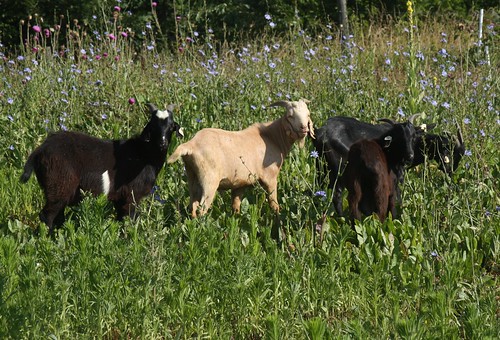On June 6, fecal egg counts ranged from 0 to 8,500 and averaged 1,202 eggs per gram. Per test protocol, all goats were dewormed with moxidectin (Cydectin® 1% injectable; 1 ml/110 lbs.) and levamisole (Prohibit® drench; 1.5x the sheep dose).
 The fecal egg count of the pooled sample collected on June 6 was 533 eggs per gram and was 84% Haemonchus (barber pole worm) and 16% Trichostrongylus.
The fecal egg count of the pooled sample collected on June 6 was 533 eggs per gram and was 84% Haemonchus (barber pole worm) and 16% Trichostrongylus.
On June 18, fecal egg counts ranged from 0 to 300 and averaged 14 eggs per gram. Anthelmintic treatments on June 6 reduced egg counts by more than 95%. There were not enough eggs in the pooled sample (only 33 epg) for coproculture.
On July 1, fecal egg counts ranged from 0 to 2,400 and averaged 271 eggs per gram. Based on FAMACHA© scores, one goat was dewormed with moxidectin. The pooled fecal sample had an egg count of 300 eggs per gram and was 93% Haemonchus and 7% Trichostrongylus. In the individual fecal samples, the lab technician noted "lots of hookworm and tapeworm eggs throughout the samples.
On July 16, fecal egg counts ranged from 0 to 2,525 and averaged 335 eggs per gram. Based on FAMACHA© scores, five goats were dewormed with moxidectin. The pooled sample had an egg count of 680 eggs per gram and was 80% Haemonchus and 20% Trichostrongylus. According to the Culture ID Report, there was a significant number of unidentified larvae (approximately 15-20%), possibly Bunostomun (hookworm) or Strongyloides.
On July 30, fecal egg counts ranged from 0 to 3,225 and averaged 663 eggs per gram. According to the lab technician, several samples had tapeworm or whipworm eggs. Some had coccidia oocytes. Based on FAMACHA© scores, no goats required deworming.
Fecal egg counts are determined by Dr. Dahlia Jackson-O'Brien's lab at Delaware State University using a modified McMaster procedure. Coproculture (larave ID) is done by Dr. Ray Kaplan's lab at the University of Georgia.
Download July 30 Parasite Report











